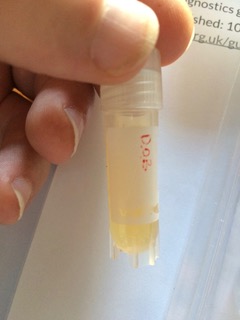PART 1: The Early Signs
Where to begin? My wife Sheila, has
had issues with her bowel for over ten years. It really first became an issue
in 2009 when we were on vacation in a remote camp inside 6500 square miles of
nothingness on the Skeleton Coast of Namibia. We had nothing that would help
relieve the discomfort there, but she was able to get Mebeverine from a pharmacist once we reached South Africa, which settled her stomach
- at least for a little while.
Once we got home, Sheila reported in
to the doctor who ran multiple tests. The tests suggested a lactose intolerance but
nothing much more. She was then sent for a colonoscopy that showed a nice clear
and healthy bowel. After that she was sent to see the UK’s leading specialist
professor in the field, who diagnosed her with IBS and took her into his care.
He tried various drug combinations and hypnotherapy over the years to try to alleviate her
symptoms, however, nothing really helped. Sheila soldiered on, coping with
her symptoms every day with grace and composure.
In 2015, Sheila reported to the
professor’s specialist team with worsening symptoms and she was prescribed a
bile sequestrant, Colesevelam, to see if it would help control the gel-like
motions she was passing all the time. It didn’t. Instead, things got steadily
worse - all the time, being put down to IBS by that team.
In the autumn of 2016, the professor
wrote to Sheila, telling her that he was retiring and there was nothing more he
or his team could do for her. She was left without an answer; adrift and
confused.
Throughout 2017, Sheila continued to
take her Colesevelam through ever worsening symptoms. By April of 2018, she was
so fed up that she reported back to her doctor to see if she could be referred
for more tests for her IBS because it was becoming debilitating.
Through a fast track referral from her
doctor, Sheila received an MRI scan, CAT scan, and two colonoscopies – all
inside the month of May. The terms each doctor used after each step became more
and more alarming. First it was “ hmm, I think I might feel something
up there”. Then “it’s a significant polyp”, to “it’s a tumour”, to “it’s a carpet mass”, all in rapid succession.
Ultimately, May of 2018 was a pretty
scary month for us. Then the worse news came. At the beginning of June, we
received a diagnosis that a villous adenoma had grown and it had likely become
malignant.
There was a “but” at this juncture
though. The “but” was that none of the biopsies taken during the colonoscopies
showed any malignancy although the MRI showed that a part of the adenoma looked
to have breached the bowel. As far as Sheila’s surgeon was concerned, there was
only one thing that could do that and that was cancer. Either way, she said, the tumour was about six inches long and had to be removed.
We were devastated, left reeling. This
had gone from IBS to cancer in the space of a month. Everybody knows the
dreadful statistics of the likelihood of getting cancer at some point in their
lives and yet, it’s always something that happens to someone else. Now it was
a reality, for us.
Because Sheila’s surgeon believed it to be cancer, she asked an oncologist to get involved and they could take a multidisciplinary team
decision about the next steps. When we saw the oncologist, he told us that even though there was no proof
positive that the adenoma was malignant, some neoadjuvant radiotherapy and
chemotherapy would be given before the tumour would be removed. He then
suggested Sheila should have an ileostomy first to improve her quality of life,
because radiotherapy and chemotherapy would make her diarrhoea even worse.
So, I asked him the following
question: since Sheila’s surgeon had told us the tumour had to come out,
cancerous or not, why not just cut it out now and be done with it? He told us that they needed to
shrink any cancerous part of the tumour and grow normal cells over it so it
could be safely removed. I pointed out that they didn’t even know there was any
cancer there anyway. However, we went away from that meeting with a plan that on 21 June, Sheila would have an ileostomy and by the beginning of August, she would
begin radiotherapy and chemotherapy followed by a wait period. After that, they would check to see if the tumour had shrunk and then, all being well, she would have a low anterior resection
in November. As we left though, the oncologist did say that since I had asked my
question, he would arrange to hold another multidiscipline team meeting to
review Sheila’s results again.
Just as we were getting our heads
round that plan, Sheila got a call from her surgeon to say that she was
postponing her ileostomy and that she should go and see her. “Oh well it is the
NHS and there must be some other poor soul who needs an operation more than
Sheila” I told myself. “Her surgeon wants to apologise for having to postpone
her operation and to assure us that it wouldn’t affect her prognosis”. I said I would go again with Sheila
to that next meeting to fight her corner. I wanted to make sure that her surgeon
understood we needed Sheila to get on with the plan right away, before the
tumour grew any bigger.



Comments
Post a Comment